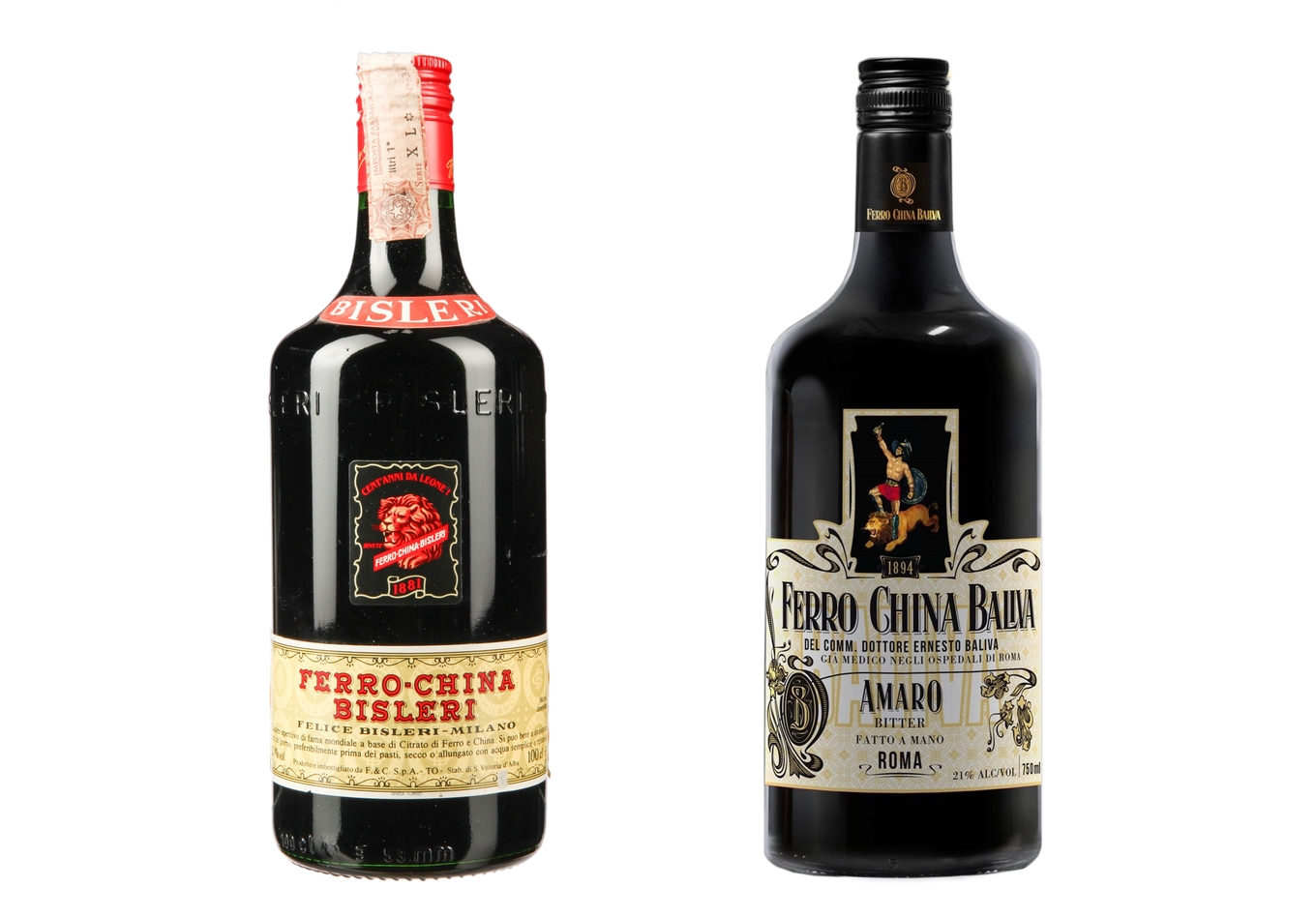Are you a Discerning Drinker?
Join thousands of like-minded professionals and cocktail enthusiasts, receive our weekly newsletters and see pages produced by our community for fellow Discerning Drinkers.
Words by Simon Difford

Amari (plural of amaro) are traditional Italian bitter aperitivo or digestivo liqueurs and Ferro China are a distinctive sub-category of amari containing iron ammonium citrate (hence "ferro") and cinchona bark (china). The iron gives Ferro China its red hue and delicious citrus notes. It is sometimes called "the iron amaro."
Ferro China amari are particularly identified with Italian capital where this dark coloured liqueur, dating back to the late 1800s, is traditionally enjoyed over ice as an aperitivo or digestive tonic. Ferro China is also a versatile cocktail ingredient [Ferro China cocktail recipes].
Baliva Ferro China, formulated in Rome by Doctor Ernesto Baliva in 1894, is the last remaining traditional Italian Ferro China in production and is still made in Rome by Pallini S.p.A..

History & meaning of the Ferro China name
Ferro, from the Latin word for iron ferrum, indicates the presence of iron – as in the term ferrous metals which mostly contain iron versus non-ferrous metals that have little or no iron. The "ferro" in ferro china also indicates the presence of iron, in the form of Ferric Ammonium Citrate (NH₄)₅[Fe(C₆H₄O₇)₂].
Iron plays an important role in the formation of red blood cells, which carry oxygen around the body, and an iron deficiency can lead to anaemia – commonplace after blood loss or pregnancy. Symptoms include pale skin, tiredness, lack of energy, shortness of breath and heart palpitations.
To treat iron anaemia, doctors prescribe iron tablets and instruct patients to eat iron-rich foods such as meat, dark-green leafy vegetables, pulses and lentils. Drinking orange juice after you've taken iron supplements helps iron absorption [perhaps worth remembering when formulating cocktails with Ferro China].
Back in the late 1800s Rome, iron anaemia was common due to poor diet and a lack of meat. Ferro China was formulated in Rome at this time and is the world's first liqueur to be made with the salt of a metal: Ferric Ammonium Citrate. The liqueur was considered an invigorating tonic and blood supplement, but also consumed and enjoyed as an aperitivo or digestivo.
China refers to Ferro China's recipe including cinchona, a bark containing quinine, long considered a malaria remedy. Indeed, research suggests that cinchona alkaloids are effective in treating strains of malaria which have evolved resistance to modern synthetic drugs.
When Ferro China was first formulated in the 1890s, epidemics of malaria were commonplace in Rome due to The Pontine Marshes, a vast tract of marshland extending along the southeast coast of the city. This wasn't drained, and the land reclaimed until Benito Mussolini's regime in the 1930s. Malaria plagued Rome through millennia and Roman Fever is a particularly deadly strain of malaria which may have contributed to the fall of the Roman empire during fifth century AD.
Thus, Ferro China contains both a form of iron more easily absorbed by the body (Ferric Ammonium Citrate), and quinine so the liqueur helped alleviate the iron anaemia and malaria in the population of Rome.
Tonic liqueur
Ferro China was created on the back of the popularity of tonics purported to have properties beneficial to health, a drinks category which kicked off in the second half of 17th century when pharmacies started to advertise, and entrepreneurial doctors began to promote their digestive amaro and other "miraculous" products.
Huge profits were made on these cleverly marketed and cheap-to-produce tonics, so generating advertising budgets such that by 1850, these pharmaceutical products took over from food and consumer goods, and by the end of the 17th century, even wines and vermouths, to be the main source of advertising revenue for newspapers.
These alcoholic tonic liquors were sold without requiring a medical prescription, but they carried healing claims and recommended dosages on their labels. They were sold as a treatment for everything from venereal disease, which was very common at the time, to impotence and balding, with their health-giving claims backed up by medals and certificates which were often counterfeit or issued without any assessment of their effectiveness.
Italian pharmacies and grocery stores started distributing both domestic and foreign tonics and this increased competition drove even more advertising with first advertising agency, Manzoni & Co of Milano, founded in 1863 by a pharmacist, Attilio Manzoni.
The first iron-based 'medicinal' products were sold to cure ailments such as fatigue and anaemia, but they tasted horrible. When it came onto the market, Ferro China offered more perceived health-benefits and it tasted good. As described above, it combined two remedies, Ferro in the form of iron citrate to fortify the blood, and China (quinine) to ward against malaria.
It was believed the iron salts and quinine composition of Ferro China, along with its other perceived health benefitting botanicals, were more easily metabolised (broken down and absorbed) due to their being infused in alcohol. Hence, in Italy Ferro China was considered a miraculous tonico-ricostituente (health tonic) with digestive properties taken as a supplement and a cure for malaria.
Vintage lables of Ferro China Baliva claim:
"Sovereign in stomach atonic, in chlorosis anaemias, in neurasthenia in general. Great strength regenerator after exhaustive infectious diseases like typhus and flu, after the perperium and during lactation. Pleasant taste. It is taken with pleasure by children and ladies. Use for adults: one small glass an hour before each meal, for children: a teaspoon before each meal."
Another marketing innovation was Ferro China being one of the few products targeted at women with young children. Mothers mixed a spoonful of the liqueur with whipped egg yolk and sugar to improve their children's nutrition and generations of Italians grew up being given a daily spoon of Ferro China, as illustrated in this vintage advertisement on our Bisleri Ferro China page.
Sales exploded in Italy, but Ferro China was also hugely popular in Asia and India where it was mixed with water as a purifier. During Prohibition in the United States, Ferro China was sold in pharmacies, and like medicines, to this day the liqueur is bottled in dark glass to protect it from light.
Meanwhile, amari and vermouth begun to be viewed as luxury products taken for pleasure while Ferro China and other tonics were regarded purely as functional, only to be taken for their medicinal qualities. It is telling that of the many cocktail books produced during this period, only a very few include a recipe using Ferro China. Indeed, one of the most important liquor manuals of its time, the 1897 Il Liquorista Pratico (The Practical Liquorist) by Luigi Sala says that "Ferro China liqueur came out a few years ago but didn't stick in spite of the aggressive advertising campaigns promoted by its inventor. Even though it's been successful in the export channel, it didn't become popular or much utilized, in Italy".
The death knell was struck for most liquori curative (healing spirits) in 1927 when the first laws restricting misleading health claims in advertisements were introduced. Despite this, perceptions of Ferro China's health benefits persisted in Italy where it remained popular, particularly in Rome, until the late 1970s when its rapid decline started. Diageo acquired Bisleri Ferro China, then the last surviving major brand, and subsequently ceased its production in January 2015.
Ferro China almost disappeared as a category, but it was saved when Pallini S.p.A. acquired the rights to Baliva Ferro China in 2016 and restarted production in 2017. Baliva Ferro China is now the only Ferro China still in production.

Baliva conquers Bisleri
Felice Bisleri, an Italian entrepreneur, patented his Ferro China in 1881 but it didn't achieve significant sales or popularity until 13 years later in 1894 when Bisleri also purchased the Nocera Umbra spring and began to sell the mineral water in hospitals and where water wasn't potable. He advertised the water widely in Italy, often alongside his Ferro China brand. It is this advertising that established Ferro China.
It is perhaps no coincidence that Doctor Ernesto Baliva, a pharmacist working in Rome's hospitals, developed his Ferro China recipe in 1894 and started supplying the city's pharmacies. Unlike Bisleri, Baliva concentrated on local distribution and advertising, immediately becoming the dominant brand of Ferro China in Rome and the wider Lazio region. Bisleri's label depicts a gladiator (the symbol of Rome) crushing the head of a slane lion and his advertisements replicated this label, with the gladiator representing Baliva conquering Bisleri's lion.
Over the decades other Ferro China brands emerged (including: Aquileia, Bonomelli, Comar, Ferrol, Gorizia, Guasti, Sac) but Bisleri and Baliva remained the market leaders competing against each other with Baliva being dominant in Rome and surrounding regions, while Bisleri remained the bigger brand across the rest of Italy. As Baliva is now the only surviving brand of Ferro China it would appear that the scenario depicted on Baliva's label has indeed played out.








